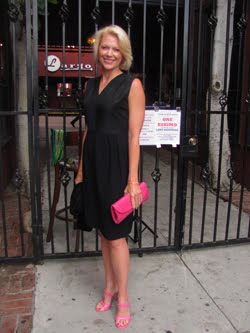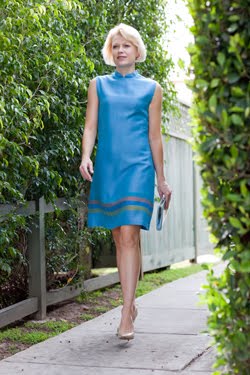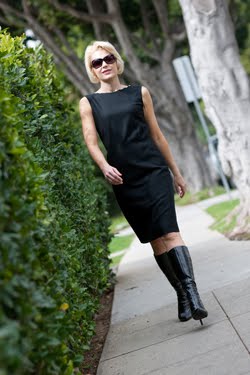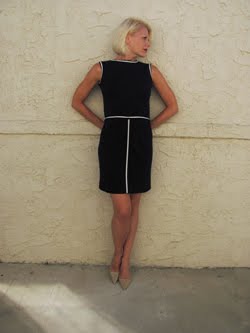There are some movies that are so sexy and sizzle no matter how often you see them, and Charles Vidor's 1946 classic Gilda is definitely one. Film noir is already a favorite genre of mine, but the characters in Gilda are so taut with tension and visuals so rich that there's something exceptional to experience each and every time. Let's start with the obvious reason why: Rita Hayworth. Rita was--and still is--a woman who makes mere mortals swoon and this role of a femme fatale seems custom-made for her. Though she had crept into our consciousness in Howard Hawks' Only Angels Have Wings (1939) and established her dancing in movies like You Were Never Lovelier (1942) with Fred Astaire and Cover Girl (1944) with Gene Kelly, it was Gilda that secured Rita's star in the heavens.
Rita was always talented, but it took some confidence-building and other changes over the years to bring out what was naturally in her genes. Born Margarita Cansino, her mother Volga was a Ziegfeld Girl and her father Eduardo owned a dancing studio where he taught the likes of James Cagney and Jean Harlow. Though Rita danced and performed in public with her father from a very early age, she was not immediately loved on screen. In fact, she was so lackluster that Fox decided to drop her after only a few pictures. Her first husband (there were five, including Orson Welles) encouraged painful electrolysis to change her hairline and hair color to change her image. And change it did--that long red hair soon became a signature, in a style that seems influenced by Veronica Lake before her. Thus "Rita Cansino" came back as "Rita Hayworth" and was signed to a contract with Columbia Pictures.
There were several planets in alignment with the making of Gilda and its team could not have been stronger. Two of its great talents were the cinematographer and costume designer--Rudolph Maté and Jean Louis. These men more than any other are what allowed Rita to shine so bright. Rudolph Maté is a star in film noir, known for his lush and beautiful cinematography both in and out of the genre. The look of Alfred Hitchcock's Foreign Correspondent (1940), Orson Welles' The Lady from Shanghai (1947, again starring Rita), and Ernst Lubitsch's To Be or Not to Be (1942) are also due to his work. He even directed some of the best in film noir, including the classic D.O.A. (1950). There is a depth to Maté's black and white that is unmatched by most in film, and for this reason he is one of my favorite cinematographers. Interestingly, he was behind the camera for Rita's screen test at Columbia and was largely responsible for head Harry Cohn seeing her potential. And of course he was a perfect partner on Gilda with director Vidor, whose unique framing often reminds me of George Stevens in later movies like A Place in the Sun (1951).
Gilda is known for its glamour and one of the greatest movie wardrobes of all time. Rita was growing in popularity with the public, and the studio invested $60,000 in clothes alone to dress its "Love Goddess" for this film. Though it included smart tailored suits that were de rigueur for the 1940s, it is best known for its gorgeous gowns. One, in particular, is iconic--the strapless black satin number she wears to striptease while singing "Put the Blame on Mame." With design inspired by John Singer Sargent's famous painting Madame X, Louis captured the mood and mystery of the portrait for the character of Gilda. Audiences were in absolute awe because it seemed to defy gravity; no matter how much Rita moved in her dance, the dress did not. The gown was a marvel of engineering in addition to its beauty. As Jean recalled,
It was the most famous dress I ever made....Inside there was a harness like you put on a horse. We put grosgrain under the bust with darts and three stays, one in the centre, two on the sides. Then we moulded plastic softened over a gas flame and shaped around the top of the dress. No matter how she moved, the dress did not fall down.
With this costume, as well as others in the movie, Jean did what all the great costume designers did--he made the star look her absolute best. It may seem hard to believe, but even Rita Hayworth had her flaws. "Rita had a good body. It wasn't difficult to dress her," Louis said. "She was very thin-limbed-- the legs were thin, the arms long and thin, and she had beautiful hands. But the body was thick. She also had a belly then [some due to Rita's recent pregnancy], but we could hide that." You'll notice in her "Mame" gown that Louis includes a faux tie to the side that somewhat conceals her mid-section. Another gown in the film has ruching around the middle that offers much the same effect. Several gowns throughout bare her shoulders, which acts to draw the eye upward. Still other dresses include wide belts that help define her waist. Everything was done to make sure each was fit to flatter Rita's 5'6" figure.
One must also remember that the Hays Code was very much in effect during this time and costume designers were restricted in many ways. Nothing could hint at nudity, and those enforcing the production code could censor any costumes they found too suggestive or revealing. Cleavage (or even the shadow of it) was objectionable as was the sight of a woman's belly button. Yet, even with the Code attempting to dictate design, Jean's gowns are still sublimely sensual. The "Amado Mio" gown is a perfect illustration of him working around the Code. The two-piece design is backless and bares much of her middriff (without exposing her navel, of course), yet its long sleeves make her seem much more covered than she really is. Also, like the gown for "Mame," Louis included high side slits that are largely hidden until Rita dances. Only then do they reveal and highlight her long lovely legs.
Gilda is one of The Style Essentials on GlamAmor for the influence of its costume design--both then and now. In the 1930s and 1940s, films were at the forefront of fashion. Because of the production process, films were generally made a year or so before their release. Thus, costume designers had to be ahead of trends and often set them once the movie premiered; for decades, they largely determined how women dressed. Rita's strapless "Mame" gown captured the imagination of audiences at the time and the design's popularity would continue well into the 1950s. Though Travis Banton had created a strapless gown for film two years earlier, it was Louis' look in Gilda that inspired the trend. In fact, the Gilda gown is so iconic that it continues to inspire fashion today. You would be hard-pressed to find an awards show red carpet that doesn't have at least one dress that owes some of its design to Jean Louis.
With so many talents all coming together to create the character of Gilda--Jean Louis, Rudolph Maté, Charles Vidor, and of course Rita Hayworth--it's no wonder that the movie became a phenomenon. As a result, Rita became one of the top glamour girl pin-ups of the 1940s and beloved by men all over the world. Co-star Glenn Ford (Johnny Farrell) confessed his own affection years later, which explains why their on-screen chemistry was so strong. But Rita understood all the pieces that had to be put together to make Gilda possible, and believed that precious few had to do with the real (and painfully shy) Margarita Cansino. She once famously said, "Men fell in love with Gilda, but they wake up with me." That may be true, but I, for one, don't think that anyone should have been complaining.
One of the best movie introductions in history with just a flip of her hair:
"Gilda...are you decent?" asks Ballin Mundson (George Macready, above right).
"Me?"
Former lovers Johnny Farrell (Glenn Ford) and Gilda, now Mrs. Ballin Mundson, meet...
...and the scheming begins in a seemingly innocent belted silk chiffon dressing gown
The next gown is not so innocent...
strong 40s shoulders, sequins top to toe, and slinky and sexy as hell
Gilda flaunts her new-found wealth to Johnny--
a 50,000 peso piece of jewelry that she thinks is "cute"
Dancing with a stranger to stir up jealousy...not in her husband, but in Johnny
Vidor constantly shoots Johnny and Gilda as close as can be,
even when they're sitting at a table with Ballin
A zipper's not the only thing that's tricky in Gilda's life...
Ballin could feel the heat of hatred in the evening and warns Gilda not to make a mistake
Gilda, a great believer in luck, tries hers at the casino tables in this goddess gown...
note how the bracelet matches the belt
note how the bracelet matches the belt
Incredible draping in this grecian gown with ruching at the waist
Gilda's beaded jacket (over the grecian gown) is as much as a knock-out as her date from the casino
Another grecian-inspired dress as Gilda sings "Put the Blame on Mame" for the first time
Look at the studded belt and matching cuff that go with the cover-up dress--
perfectly on trend for today and suggest Gilda as a warrior in this psychological battle
Vidor shoots Ballin in interesting ways throughout the movie--often without his head showing (above)
or fully dark in silhouette that speaks to the ominous threat he imposes
Gilda getting ready to don her costume for carnival
Even Ballin points out that Gilda is "armed" with her whip,
ever ready for battle with Johnny even in costume
Johnny is tortured both by Ballin's orders to take care of Gilda
and Gilda making mischief with every man she meets
The energy and anticipation from carnival is too much for the former lovers...
...and they find themselves locked in a kiss
(notice how Vidor keeps the wedding ring front and center in the shot)
Ballin bursts in on the couple and runs for a plane that crashes into the sea
With Ballin's death, the couple is now free to marry
The choice of a black satin suit is an interesting choice and foreshadows what's to come...
still angry at Gilda, Johnny has set a trap that she cannot free herself from
Once trapped to live a loveless existence, Gilda tries to turn to others...
going out night after night in several strapless gowns
Gilda runs to Montevideo to try and escape,
signing on as a showgirl performing "Amado Mio"in a two-piece (and backless) white beaded gown
Gilda mistakenly tries to trust another man, who ends up bringing her right back to Johnny
In a classic 40s pinstripe suit to fight with Johnny Farrell
At her desperate breaking point, Gilda performs "Put the Blame on Mame" again
in Jean Louis' iconic black strapless satin gown that seems to defy gravity
Feeling like a kept whore,
Gilda performs her version of a striptease to show the world what she's become
Gilda performs her version of a striptease to show the world what she's become
After such an exhibition, Johnny and Gilda finally come together and speak heart to heart,
but someone sinister appears in the midst of it all...Ballin
but someone sinister appears in the midst of it all...Ballin
The final fight at the casino and the lovers are left in peace
Sources (in addition to my own knowledge)
Independent.co.uk
FilmReference.com
Leaming, Barbara. If This Was Happiness: A Biography of Rita Hayworth. New York: Viking Penguin, 1989.
All screen captures by Kimberly Truhler for GlamAmor


























































































































































1 comment:
Wow...what a GREAT post, Kimberly! Wouldn't we all love to have those matching belts-n-bracelets? They are wonderful! Rita is a fascinating person...I'm so glad you put up these stellar screen caps.
Wonderful way to start August!
Thanks,
Kay
moviestarmakeover.blogpost.com
Post a Comment